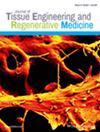应用仿骨纳米粘土支架的癌症患者源性骨转移体外模型
IF 3.1
3区 生物学
Q2 BIOTECHNOLOGY & APPLIED MICROBIOLOGY
Journal of Tissue Engineering and Regenerative Medicine
Pub Date : 2023-03-11
DOI:10.1155/2023/5753666
引用次数: 0
摘要
研究癌症骨转移的可靠模型不可用是晚期癌症患者预后不良的主要挑战。癌症乳腺细胞倾向于优先扩散到骨骼,并在重塑骨骼内定植,导致骨骼转移。为了改善乳腺癌症骨转移患者的预后,我们之前使用人间充质干细胞(hMSC)和原发性癌症细胞系(MCF-7和MDAMB231)开发了一种3D体外乳腺癌症骨转移模型,重现了癌症骨转移的晚期。在本研究中,我们使用hMSC和表现出不同特征的患者来源的癌症细胞系(NT013和NT023)测试了我们的模型。我们使用这种3D体外模型研究了癌症转移对骨生长的影响,并将我们的结果与先前的研究进行了比较。结果显示,NT013和NT023 表现出激素阳性和三阴性特征的细胞经历了间充质-上皮转化(MET),并在骨微环境存在的情况下形成肿瘤,这与我们之前对MCF-7和MDAMB231的研究结果一致 细胞系。此外,研究结果显示,在NT013释放过量ET-1细胞因子的情况下培养的hMSCs中,Wnt相关基因上调 细胞,同时在存在过量DKK-1的情况下下调Wnt相关基因,由NT023释放 细胞,分别导致成骨途径的刺激和消除,最终模仿癌症患者不同类型的骨病变。本文章由计算机程序翻译,如有差异,请以英文原文为准。
Patient-Derived Breast Cancer Bone Metastasis In Vitro Model Using Bone-Mimetic Nanoclay Scaffolds
The unavailability of reliable models for studying breast cancer bone metastasis is the major challenge associated with poor prognosis in advanced-stage breast cancer patients. Breast cancer cells tend to preferentially disseminate to bone and colonize within the remodeling bone to cause bone metastasis. To improve the outcome of patients with breast cancer bone metastasis, we have previously developed a 3D in vitro breast cancer bone metastasis model using human mesenchymal stem cells (hMSCs) and primary breast cancer cell lines (MCF-7 and MDAMB231), recapitulating late-stage of breast cancer metastasis to bone. In the present study, we have tested our model using hMSCs and patient-derived breast cancer cell lines (NT013 and NT023) exhibiting different characteristics. We investigated the effect of breast cancer metastasis on bone growth using this 3D in vitro model and compared our results with previous studies. The results showed that NT013 and NT023 cells exhibiting hormone-positive and triple-negative characteristics underwent mesenchymal to epithelial transition (MET) and formed tumors in the presence of bone microenvironment, in line with our previous results with MCF-7 and MDAMB231 cell lines. In addition, the results showed upregulation of Wnt-related genes in hMSCs, cultured in the presence of excessive ET-1 cytokine released by NT013 cells, while downregulation of Wnt-related genes in the presence of excessive DKK-1, released by NT023 cells, leading to stimulation and abrogation of the osteogenic pathway, respectively, ultimately mimicking different types of bone lesions in breast cancer patients.
求助全文
通过发布文献求助,成功后即可免费获取论文全文。
去求助
来源期刊
CiteScore
7.50
自引率
3.00%
发文量
97
审稿时长
4-8 weeks
期刊介绍:
Journal of Tissue Engineering and Regenerative Medicine publishes rapidly and rigorously peer-reviewed research papers, reviews, clinical case reports, perspectives, and short communications on topics relevant to the development of therapeutic approaches which combine stem or progenitor cells, biomaterials and scaffolds, growth factors and other bioactive agents, and their respective constructs. All papers should deal with research that has a direct or potential impact on the development of novel clinical approaches for the regeneration or repair of tissues and organs.
The journal is multidisciplinary, covering the combination of the principles of life sciences and engineering in efforts to advance medicine and clinical strategies. The journal focuses on the use of cells, materials, and biochemical/mechanical factors in the development of biological functional substitutes that restore, maintain, or improve tissue or organ function. The journal publishes research on any tissue or organ and covers all key aspects of the field, including the development of new biomaterials and processing of scaffolds; the use of different types of cells (mainly stem and progenitor cells) and their culture in specific bioreactors; studies in relevant animal models; and clinical trials in human patients performed under strict regulatory and ethical frameworks. Manuscripts describing the use of advanced methods for the characterization of engineered tissues are also of special interest to the journal readership.

 求助内容:
求助内容: 应助结果提醒方式:
应助结果提醒方式:


